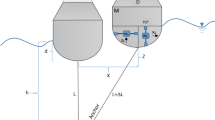Abstract
One of the new methods for powering low-power electronic devices at sea is a wave energy harvesting system. In this method, piezoelectric material is employed to convert the mechanical energy of sea waves into electrical energy. The advantage of this method is based on avoiding a battery charging system. Studies have been done on energy harvesting from sea waves, however, considering energy harvesting with random JONSWAP wave theory, then determining the optimum values of energy harvested is new. This paper does that by implementing the JONSWAP wave model, calculating produced power, and realistically showing that output power is decreased in comparison with the more simple airy wave model. In addition, parameters of the energy harvester system are optimized using a simulated annealing algorithm, yielding increased produced power.
Similar content being viewed by others
References
Adrezin R, Haym B (1999). Response of a tension leg platform to stochastic wave forces. Probabilistic Engineering Mechanics, 14 (1), 3–17. DOI: 10.1016/S0266-8920(98)00012-5
Ali SF, Michael F, Sondipon A (2011). Analysis of energy harvesters for highway bridges. Journal of Intelligent Material Systems and Structures, 22(16), 1929–1938. DOI: 10.1177/1045389X11417650
Carter DJT (1982). Prediction of wave height and period for a constant wind velocity using the JONSWAP results. Ocean Engineering, 9(1), 17–33. DOI: 10.1016/0029-8018(82)90042-7
Deb K (2001). Multi-objective optimization using evolutionary algorithms. John Wiley & Sons, Inc., Chichester, UK.
Erturk A (2011). Piezoelectric energy harvesting for civil infrastructure system applications: Moving loads and surface strain fluctuations. Journal of Intelligent Material Systems and Structures, 22 (17), 1959–1973. DOI: 10.1177/1045389X11420593
Farinholt KM, Miller N, Sifuentes W, MacDonald J, Farrar CR (2010). Energy harvesting and wireless energy transmission for embedded SHM sensor node. Structural Health Monitoring, 9(3), 269–280. DOI: 10.1177/1475921710366647
Han SM, Benaroya H (2000). Non-linear coupled transverse and axial vibration of a compliant structure, Part 2: Forced vibration. Journal of Sound and Vibration, 237(5), 875–900. DOI: 10.1006/jsvi.2000.3148
Haritos N (2007). Introduction to the analysis and design of offshore structures—An overview. Electronic Journal of Structural Engineering Special Issue: Loading on Structures, 7, 55–65.
Haupt RL, Haupt SE (2004). Practical genetic algorithms. 2nd ed, John Wiley & Sons, Hoboken, USA.
Kern W(1991). Simulated annealing and Boltzmann machines: A stochastic approach to combinatorial optimization and neural computing (Emile Aarts and Jan Korst). SIAM Review, 33(2), 323–323. DOI: 10.1137/1033080
Kim SH, Ahn JH, Chung HM, Kang HW (2011). Analysis of piezoelectric effects on various loading conditions for energy harvesting in a bridge system. Sensors and Actuators A: Physical, 167(2), 468–483. DOI: 10.1016/j.sna.2011.03.007
Kumari Ramachandran GKV (2013). A numerical model for a floating TLP wind turbine. Ph.D. thesis, Technical University of Denmark, Kgs. Lyngby, Denmark.
Lee CK, Moon FC (1990). Modal sensors/actuators. Journal of Applied Mechanics, 57(2), 434–441. DOI: 10.1115/1.2892008
Liang Junrui, Liao Weihsin (2012). Impedance modeling and analysis for piezoelectric energy harvesting systems. IEEE/ASME Transactions on Mechatronics, 17(6), 1145–1157. DOI: 10.1109/TMECH.2011.2160275
Liu Zhou, Frigaard P (1999). Generation and analysis of random waves. Aalborg Universitet, Aalborg, Denmark.
Morison JR, Johnson JW, Schaaf SA (1950). The force exerted by surface waves on piles. Journal of Petroleum Technology, 2(5), 149–154. DOI: 10.2118/950149-G
Murray R, Rastegar J (2009). Novel two-stage piezoelectric-based ocean wave energy harvesters for moored or unmoored buoys. Proc. SPIE 7288, Active and Passive Smart Structures and Integrated Systems 2009, San Diego, USA, 72880E. DOI: 10.1117/12.815852
Nagayama T, Jung HJ, Spencer Jr BF, Jang S, Mechitov KA, Cho S, Ushita M, Yun SB, Agha GA, Fujino Y (2010). International collaboration to develop a structural health monitoring system utilizing wireless smart sensor network and its deployment on a cable-stayed bridge. 5th World Conference on Structural Control and Monitoring, Tokyo, Japan, 1–10.
Osman IH, Potts CN (1989). Simulated annealing for permutation flow-shop scheduling. Omega, 17(6), 551–557. DOI: 10.1016/0305-0483(89)90059-5
Park JW, Jung HJ, Jo H, Jang S, Spencer Jr BF (2010). Feasibility study of wind generator for smart wireless sensor node in cable-stayed bridge. Proc. SPIE 7647, Sensors and Smart Structures Technologies for Civil, Mechanical, and Aerospace Systems 2010, San Diego, USA, 764747. DOI: 10.1117/12.853600
Seyul S (2006). Design of ocean platforms against ringing response. Ph.D. thesis, Texas Tech University, Lubbock, USA.
Shigley JE, Mischke CR, Richard GB (2004). Mechanical engineering design. McGraw-Hill, New York, USA.
Taylor GW, Burns JR, Kammann SA, Powers WB, Welsh TR (2001). The energy harvesting eel: A small subsurface ocean/river power generator. IEEE Journal of Oceanic Engineering, 26(4), 539–547. DOI: 10.1109/48.972090
Van Laarhoven PJM, Aarts EHL (1987). Simulated annealing: Theory and applications. Springer, Amsterdam, The Netherlands, 7–15. DOI: 10.1007/978-94-015-7744-1
Wang Huiming, Zou Long (2013). Interfacial effect on the electromechanical behaviors of piezoelectric/elastic composite smart beams. Journal of Intelligent Material Systems and Structures, 24(4), 421–430. DOI: 10.1177/1045389X12461723
Williams CB, Yates RB (1996). Analysis of a micro-electric generator for microsystems. Sensors and Actuators A: Physical, 52(1), 8–11. DOI: 10.1016/0924-4247(96)80118-X
Wu Nan, Wang Quan, Dong Xiexiang (2015). Ocean wave energy harvesting with a piezoelectric coupled buoy structure. Applied Ocean Research, 50, 110–118. DOI: 10.1016/j.apor.2015.01.004
Wu X, Lee D W(2014). An electromagnetic energy harvesting device based on high efficiency windmill structure for wireless forest fire monitoring application. Sensors and Actuators A: Physical, 219, 73–79. DOI: 10.1016/j.sna.2014.09.002
Xie XD, Wang Q, Wu N (2014a). Energy harvesting from transverse ocean waves by a piezoelectric plate. International Journal of Engineering Science, 81, 41–48. DOI: 10.1016/j.ijengsci.2014.04.003
Xie XD, Wang Q, Wu N (2014b). Potential of a piezoelectric energy harvester from sea waves. Journal of Sound and Vibration, 333 (5), 1421–1429. DOI: 10.1016/j.jsv.2013.11.008
Zurkinden AS, Campanile F, Martinelli L (2007). Wave energy converter through piezoelectric polymers. Proceedings of the COMSOL Users Conference, Grenoble, France, 1–7.
Author information
Authors and Affiliations
Corresponding author
Rights and permissions
About this article
Cite this article
Mirab, H., Fathi, R., Jahangiri, V. et al. Energy harvesting from sea waves with consideration of airy and JONSWAP theory and optimization of energy harvester parameters. J. Marine. Sci. Appl. 14, 440–449 (2015). https://doi.org/10.1007/s11804-015-1327-5
Received:
Accepted:
Published:
Issue Date:
DOI: https://doi.org/10.1007/s11804-015-1327-5




